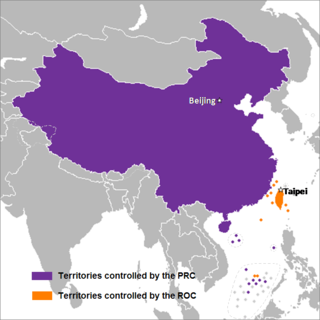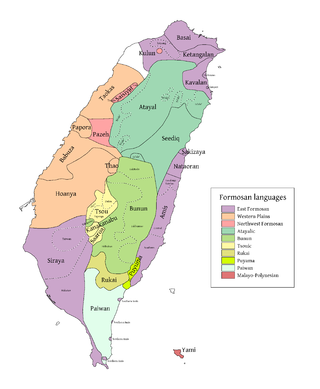
The Kaxabu people are a variant of the Pazeh/Kaxabu ethno-linguistic group of Taiwanese Aborigines.

The Kaxabu people are a variant of the Pazeh/Kaxabu ethno-linguistic group of Taiwanese Aborigines.

The Democratic Progressive Party (DPP) is a centre to centre-left Taiwanese nationalist political party in Taiwan. As the dominant party in the Pan-Green Coalition, one of the two main political camps in Taiwan, the DPP is currently the ruling party in Taiwan, leading a minority government that controls the presidency and the central government.

The Kuomintang (KMT), also referred to as the Guomindang (GMD), the Nationalist Party of China (NPC) or the Chinese Nationalist Party (CNP), is a political party in the Republic of China, initially based on the Chinese mainland and then in Taiwan since 1949. The KMT is a centre-right to right-wing party and the largest in the Pan-Blue Coalition, one of the two main political groups in Taiwan. Its primary rival is the Democratic Progressive Party (DPP), the largest party in the Pan-Green Coalition. As of 2024, the KMT is the largest single party in the Legislative Yuan. The current chairman is Eric Chu.

Taiwan, officially the Republic of China (ROC), is a country in East Asia. The main island of Taiwan, also known as Formosa, lies between the East and South China Seas in the northwestern Pacific Ocean, with the People's Republic of China (PRC) to the northwest, Japan to the northeast, and the Philippines to the south. It has an area of 35,808 square kilometres, with mountain ranges dominating the eastern two-thirds and plains in the western third, where its highly urbanized population is concentrated. The combined territories under ROC control consist of 168 islands in total covering 36,193 square kilometres. The largest metropolitan area is formed by Taipei, New Taipei City, and Keelung. With around 23.9 million inhabitants, Taiwan is among the most densely populated countries.

The Taiwan independence movement is a political movement which advocates the formal declaration of an independent and sovereign Taiwanese state, as opposed to Chinese unification or the status quo in Cross-Strait relations.

Taiwanese indigenous peoples, also known as Formosans, Native Taiwanese or Austronesian Taiwanese, and formerly as Taiwanese aborigines, Takasago people or Gaoshan people, are the indigenous peoples of Taiwan, with the nationally recognized subgroups numbering about 600,303 or 3% of the island's population. This total is increased to more than 800,000 if the indigenous peoples of the plains in Taiwan are included, pending future official recognition. When including those of mixed ancestry, such a number is possibly more than a million. Academic research suggests that their ancestors have been living on Taiwan for approximately 15,000 years. A wide body of evidence suggests that the Taiwanese indigenous peoples had maintained regular trade networks with numerous regional cultures of Southeast Asia before the Han Chinese colonists began settling on the island from the 17th century, at the behest of the Dutch colonial administration and later by successive governments towards the 20th century.

"Mainland China", also referred to as "the Chinese mainland", is a geopolitical term defined as the territory under direct administration of the People's Republic of China (PRC) in the aftermath of the Chinese Civil War. In addition to the geographical mainland, the geopolitical sense of the term includes islands such as Hainan, Chongming, and Zhoushan. By convention, territories outside of mainland China include:

Chinese unification, also known as Cross-Strait unification or Chinese reunification, is the potential unification of territories currently controlled, or claimed, by the People's Republic of China and the Republic of China ("Taiwan") under one political entity, possibly the formation of a political union between the two republics. Together with full Taiwan independence, unification is one of the main proposals to address questions on the political status of Taiwan, which is a central focus of Cross-Strait relations.
The political status of Taiwan or the Taiwan issue is an ongoing geopolitical dispute about Taiwan, currently controlled by the Republic of China (ROC), that arose in the mid-twentieth century. Originally based in mainland China before and during World War II, the ROC government retreated to Taiwan in 1949 after it was defeated by the Chinese Communist Party (CCP) during the Chinese Civil War and the subsequent establishment of the People's Republic of China (PRC). Since then, the effective jurisdiction of the ROC has been limited to Taiwan, Penghu, Kinmen, Matsu, and smaller islands.
One China is a phrase describing the relationship between the People's Republic of China (PRC) based on Mainland China, and the Republic of China (ROC) based on the Taiwan Area. "One China" asserts that there is only one de jure Chinese nation despite the de facto division between the two rival governments in the aftermath of the Chinese Civil War. The term may refer, in alphabetical order, to one of the following:

Provinces are the most numerous type of province-level divisions in the People's Republic of China (PRC). There are currently 22 provinces administered by the PRC and one province that is claimed, but not administered, which is Taiwan, currently administered by the Republic of China (ROC).
Traditional Chinese characters are a standard set of Chinese character forms used to write Chinese languages. In Taiwan, the set of traditional characters is regulated by the Ministry of Education and standardized in the Standard Form of National Characters. These forms were predominant in written Chinese until the middle of the 20th century, when various countries that use Chinese characters began standardizing simplified sets of characters, often with characters that existed before as well-known variants of the predominant forms.

The Chinese people, or simply Chinese, are people or ethnic groups identified with China, usually through ethnicity, nationality, citizenship, or other affiliation.

The Taiwan Affairs Office is an administrative agency under the State Council of the People's Republic of China (PRC). It is responsible for cross-strait relations and sets and implements guidelines and policies related to Taiwan, which is claimed by the People's Republic of China as a province of its own. Under the "one institution with two names" arrangement, it is also the Chinese Communist Party's Taiwan Work Office under the CCP Central Committee; the party title is used for party-to-party interactions with Taiwan.
Taiwanese nationalism is a nationalist political movement that promotes the cultural identity and unity of Taiwanese people as a nation. In recent decades, it consists of cultural or political movements that seek to resolve the current political and social division on the issues of Taiwan's national identity, political status, and political dispute with China. It is closely linked to the Taiwan independence movement but distinguished from it in that the independence movement seeks to eventually establish an independent "Republic of Taiwan" in place of or out of the existing Republic of China and obtain United Nations and international recognition as a sovereign state, while nationalists seek only to establish or reinforce an independent Taiwanese identity that distinguishes Taiwanese people apart from the Chinese nation, without necessarily advocating changing the official name of the country.

The Taiwan Area, fully the "Taiwan Area of the Republic of China", also the free area of the Republic of China, the "Tai-Min Area ", is a term used to refer to the territories actually controlled by the Republic of China. It has been in official use since the Additional Articles of the Constitution of the Republic of China took effect to end temporary anti-communist provisions on 1 May 1991. The term is also used in the 1992 Cross-Strait Act.
Taiwanese people are the citizens and nationals of the Republic of China (ROC) and those who reside in an overseas diaspora originated from the entire Taiwan Area. The term also refers to natives or inhabitants of the island of Taiwan and its associated islands who may speak Sinitic languages or the indigenous Taiwanese languages as a mother tongue but share a common culture and national identity. After the retreat of the Republic of China government to Taiwan in 1949, the actual-controlled territories of the government were limited to the main island of Taiwan and Penghu, whose administration were transferred from Japan in 1945, along with a few outlying islands in Fuchien Province which include Kinmen and Matsu Islands.

Taiwan Province refers to a notional administrative division claimed by the People's Republic of China. The PRC constitution asserts Taiwan as part of its territories, although the PRC has never controlled Taiwan since the PRC's establishment in 1949. The territory of the claimed province, including the entire island of Taiwan, is in actuality administered by the Republic of China (ROC) but is not coextensive with the smaller Taiwan Province of the ROC.

The island of Taiwan, together with the Penghu Islands, became an annexed territory of the Empire of Japan in 1895, when the Qing dynasty ceded Fujian-Taiwan Province in the Treaty of Shimonoseki after the Japanese victory in the First Sino-Japanese War. The consequent Republic of Formosa resistance movement on Taiwan was defeated by Japan with the capitulation of Tainan. Japan ruled Taiwan for 50 years. Its capital was located in Taihoku (Taipei) led by the Governor-General of Taiwan.

Pazeh and Kaxabu are dialects of a language of the Pazeh and Kaxabu, neighboring Taiwanese indigenous peoples. The language is Formosan, of the Austronesian language family. The last remaining native speaker of the Pazeh dialect died in 2010, but 12 speakers of Kaxabu remain.
Pan Jin-yu was the last remaining speaker of the Pazeh language of Taiwan. She was born the fifth of six children in 1914 to Kaxabu parents in Puli. Later, she was adopted by parents who were Pazeh speakers living in Auran village, which is now part of Puli township. She was said to be fully fluent in the language, despite being the only remaining speaker. However, Taiwanese Hokkien was the living language she spoke generally. She taught Pazeh classes to about 200 regular students in Puli, and there were also classes with fewer students in Miaoli and Taichung.